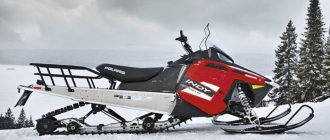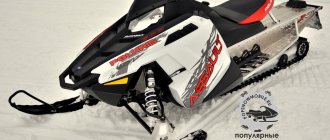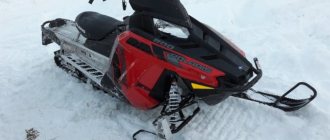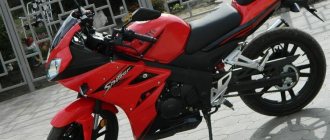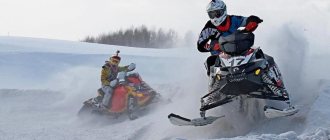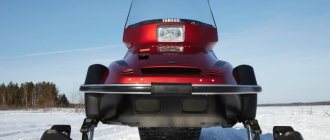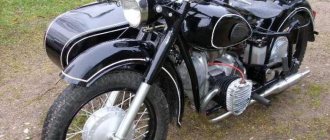New Matryx platform
A revolutionary solution that completely changes the travel experience. The MATRYX platform is distinguished by the most compact and lightweight design made of aluminum and carbon fiber, excellent handling, and high intelligent technologies. The Patriot engine delivers fast acceleration and class-leading power.
The MATRYX platform is full of innovations: from user-friendly controls, modern displays with many functions, high-quality suspension to original LED optics.
Sports snowmobile “Polaris 800 Assault RMK 146”
Snowmobiles that were originally created only for extreme sports can be counted on one hand. One of them is “Polaris 800 Assault RMK 146”. You don’t even need to think about buying it for leisurely tourist trips or using it for other utilitarian purposes. This device was created only to increase the level of adrenaline in the blood of its owner to the maximum.
SPORTS snowmobiles are an endless topic of conversation. Especially if real pros have gathered over a glass of tea.
– Why do you think the developers chose a two-stroke engine for the RMK 146? – I ask Mikhail Kufarev, the head of the Brand company’s service.
I know the answer myself, but it’s interesting to listen to a famous specialist.
“They just haven’t come up with anything better for sports yet.” Bend your fingers: lightweight, compact, repairable..
That's right. Indeed, any four-stroke engine is heavier than a two-stroke engine with similar characteristics. But in sports, every gram counts! In addition, the specific (liter) power of a two-stroke engine is always an order of magnitude higher than that of a four-stroke engine. It is also important that the two-stroke bike easily fits into the chassis of a sports snowmobile. Moreover, there is enough space left for access to it during maintenance and repair.
And if the conversation turns to repairs (and they are inevitable in sports), then any mechanic will tell you that repairing a fairly simple two-stroke engine is a pleasure compared to a much more structurally complex four-stroke engine.
– Listen, what about the environment? After all, one of the reasons why the popularity of two-stroke engines once declined was the emissions of incompletely burned oil into the atmosphere. With a separate lubrication system it simply cannot be any other way.. – Maybe. A modern two-stroke engine has a very precise dosage of oil supply - not a single extra drop is wasted. In addition, after the oil has completed its task, it burns almost completely in the cylinder and almost nothing enters the atmosphere.
...While we were talking, the mechanics started the engine of the snowmobile that I had chosen for the test. It has not yet warmed up, but there is no trace of the characteristic blue smoke from the exhaust pipe.
“You see,” Mikhail continued, “this is the merit of an engine with CFI fuel injection with two injectors per cylinder. It ensures very high cylinder filling efficiency and complete fuel combustion. Do you remember how the old two-stroke machines worked? We would already be choking on smoke here...
Rider comfort and convenience, proven in snowcross competitions
- The body at the knees is 76 mm narrower, which gives the rider more freedom of movement and makes it easier to control the snowmobile.
- Maximum wind protection for the rider and minimal air resistance are ensured by a body designed taking into account the laws of hydrodynamics.
- Narrower, profiled side panels take rider mobility to the next level, allowing the sled to move more easily than ever before.
- The combination of state-of-the-art Walker Evans Racing® Velocity shocks and IFS and IGX 146 racing suspensions give the sled better handling than ever.
Review of Polaris 800 RMK Assault 2014
Jumping down steep slopes and playing in deep snow has never been so much fun.
In the world of deep snow sleds dominated by long tracks, tapered bodies, lightweight chassis and 800cc engines, there is a niche where 800cc mountain sleds are used for uphill racing and backcountry freestyle. Among them: Ski-Doo Freeride, Arctic Cat M8000 HCR and Polaris 800 RMK Assault. The very popular Polaris RMK Pro 155 spoils the life (although not very much) of the Polaris 800 RMK Assault. Why? Well, the Pro RMK is extremely lightweight and also features the Quick Drive Low Inertia Belt Drive System – no chain drive required. But damn, how ferocious and fun the RMK Assault is on any mountain climb! It's like a climber's office on a caterpillar, suitable for the most demanding tasks.
The RMK Assault is literally built for flight and fun on rough terrain, even though it is built from racing material.
As we have already said, when creating the RMK Assault Polairs did not use the Quick Drive Low Inertia Drive System, saving it for the RMK Pro. But this does not mean that RMK Assault is worse. The Assault uses the old proven chain drive system. Over the past few seasons, we have been pestering RMK engineers about the lack of Quick Drive, to which we received reminders that professionals require a chain drive. They need a chain and gears to cope with the power of the turbo, as well as withstand collisions with large rocks and sudden stops of the track.
So Polaris created the RMK Assault as a mountain racing sled. However, it is suitable not only for racers, but for all lovers of exploring mountain slopes and canyons. The Assault, with its large Walker Evans shock absorbers, can withstand jumps of 6 meters or more.
Walker Evans shocks are a distinctive design feature of the RMK Assault (and all Assault variants) as they are designed for racing and extreme pushing.
Like the RMK Pro, the Assault uses the Liberty Clean Fire 800: 2-stroke, 2-cylinder, 795cc, liquid-cooled, fuel-injected engine; Power at sea level is 150+ hp. The ratio of cylinder diameter to piston stroke is 85 X 70 mm. The engine is equipped with a throttle position sensor, a knock sensor and the PERC - Polaris Electronic Reverse Control system. The engine runs smoothly and the power is distributed evenly across the entire range. This is a time-tested and reliable engine, and its crankcase holds up well to shock.
The standard track on the Assault is a 2.125-inch and very Shore-hard Competition. Sturdy ridges allow the track to handle sharp rocks on uphill climbs and grip frozen mud. A strong caterpillar throws itself with force onto compacted snow, but on soft and fresh snow it will bury itself. Additionally, the comb height on the Competition is not very high at 2.125 inches. When riding the RMK Assault with the Competition track, keep in mind that the sled can be a little unruly as the track braking is not as effective as the Pro model. But there is also good news.
The RMK Assault can be ordered with either the 2.125-inch Competition track or the Series 5.1 mountain track found on the RMK Pro 155.
New for 2014, the RMK Assault can now be ordered with the RMK Pro 155 Series 5.1 Mountain Truck, which features a 2.4-inch lug height. This is very good, and Polaris deserves special praise for this. When the RMK Assault first came out, it wasn't entirely clear why Polaris decided to make the Series 5.1 Mountain truck a "Spring Only" option. Yes, it continued the trend set by the Switchback Assault, which was also available with a choice of two tracks, one of which was the Spring Only. However, consumers have had their say, and now our joy knows no bounds. It seems to us that most of the RMK Assault
will be ordered with Series 5.1.
Keep in mind that the RMK Assault is only available with a 155-inch track, longer or shorter is not possible (unless you decide to customize the snowmobile yourself).
Let's summarize all of the above: in deep snow, the 2014 RMK Assault is not inferior in agility to the Ski-Doo Freeride 154 and Arctic Cat M8000 HCR. Buyers who purchased the RMK Assault later will not have to cheat and change the Competition track to the Series 5.1. This may not seem like big news, but it's a huge step for Polaris, making the RMK Assault a versatile (and year-round available) mountain sled that can take on any competitor.
The RMK Assault comes equipped with all the goodies of the RMK Pro, including Pro Taper handlebars, PowderTrac footpegs and a Pro Lite seat.
As we already said, the front and rear suspension of the RMK Assault is designed for big jumps and powerful impacts. Since the snowmobile is designed for racing, literally uphill, its skis at the front are set wider than those of the RMK Pro. The difference is 2 inches: 43.5 and 41.5, respectively. In this case, the wider the better.
Thus, the RMK Assault is equipped with a competitive Pro Ride front suspension with Walker Evans combined adjustable shock absorbers. Unlike other mountain racing sleds, the Pro Ride does not use an anti-roll bar; The snowmobile is already extremely stable thanks to the wide stance and strong Walker Evans shock absorbers. Front suspension travel is 10 inches.
The rear suspension is a Polaris RMK configuration with coilovers and Walker Evans Needle shocks. Suspension travel is 16 inches.
Like the RMK Pro, the 2014 RMK Assault features PowderTrac running boards, a carbon skid plate, and a Pro Lite seat, which we love for its narrow profile. Even though the RMK Assault has a drive chain and heavier shock absorbers, its dry weight is 435 lbs (197 kg), which is 18 (8 kg) less than the 155 RMK Pro. The difference between them is small; RMK Assault looks great among its lightweight mountain competitors.
Despite the fact that the distance between the runners is slightly greater than that of the RMK Pro, the RMK Assault 155 climbs onto a side slope without any problems.
Other standard equipment includes Pro Taper and PERC handlebars, a lightweight brake disc and a Cyclone master cylinder. Pro-Ride RMK is equipped with a vertical steering column with several right angles, ensuring smooth steering movement.
The RMK Assault's multifunctional instrument panel allows the driver to choose between a tachometer and a speedometer. The driver can monitor the time, temperature, as well as the distance traveled during the trip and the total mileage; The built-in recorder records up to three minutes.
RMK Assault is very competitive, that's for sure. But personally, we liked the strong and rugged nature of the snowmobile. The distance between the runners is greater than that of the Pro-RMK, but this is compensated by the feeling of confidence that the front of the sled can handle even the most difficult obstacles. The factory settings of the shock absorbers are quite rigid, but the preload and damping can be easily adjusted to suit your needs.
What would we choose: RMK Assault with Series 5.1 deep snow track or RMK Pro 155? This is an extremely difficult choice. Perhaps they will say that we are indecisive or too suspicious, but... We really don’t know what we would choose. Yes, it doesn’t sound very good, but these are two chic options.
Specification Polaris 800 RMK Assault 155 2014 | |
| Engine | 2-stroke 2-cylinder Polaris Liberty 795 cc. see liquid cooled; Electronic injector Cleanfire; 2-in-1 exhaust |
| Power | 150+ hp |
| Drive unit | Polaris P-85; TEAM LWT |
| Front suspension | Adjustable Pro-Ride RMK on A-arms; Walker Evans gas shock absorbers; stroke - 10 inches; Polaris “Gripper” skis |
| Rear suspension | Polaris RMK with Walker Evans shocks; travel – 16 inches |
| Length | 129.0 d. |
| Width | 48.0 d. |
| Height | 51.0 d. |
| Distance between runners | 42.5-43.5 inches (adjustable) |
| Truck | 15 x 155 x 2.15 Competition (or 15 x 155 x 2.4 Series 5.1) |
| Weight | 435 lbs -197 kg. (stated) |
| Equipment | Standard: Phantom hydraulic brake; ProTaper handlebar; Pro-lite seat; digital multifunctional instrument panel; electronic reverse Extras: Socket, electric starter, luggage, mirrors |
| Tank capacity | 43.5 liters |
Advanced Technologies
The 850 Switchback Assault 146 includes the latest technologies:
- Ride Command 7S system , which allows you to maintain communication between snowmobiles in a group via the V2V (Vehicle-to-vehicle) system, create a route plan, synchronize planned routes, past trips and waypoints, connect to a mobile phone via Bluetooth for phone calls and listening to music;
- SmartWarmers system – electronically controlled heated grips and a new intuitive switch block located on the left of the steering wheel;
- 7-inch display is optimized for use with gloves;
- the display has day and night styles of displaying information; the backlight level is adjusted automatically depending on the illumination;
- You can place the speedometer, tachometer and other sensors on the display at your discretion.
